| |
|
St Mary,
Hemsby
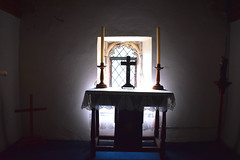 |
|
Hemsby
is a large village a few miles to the north of
Great Yarmouth, best known for its miles of sandy
beaches which are better than Yarmouth's, and
certainly a lot cleaner. The front is lined with
the usual souvenir shops and fish bars, which
Pevsner snobbishly refers to as having been thrown
up for the popular side of the holiday market,
but Hemsby is the kind of place whose seediness
is a part of its charm. I like it a lot. Hemsby has
struggled in recent years after the closure of
the Pontins holiday camp, its largest employer,
in 2009, and it also suffered badly from the
incursions of the sea in the great storm of 2013,
when half a dozen houses were lost. All in all it
is like much of the east coast - forgotten,
neglected, needy, run down, and a million miles
from the middle class intellectuals of London who
still can't understand why this part of the world
voted so strongly to leave the European Union.
|
The heart
of Hemsby village is about a mile from the sea, and
here's where the parish church is, a tall, rather stark
structure of the early 14th Century which was
substantially rebuilt in the 1860s and underwent another
major and necessary restoration in the 1970s. The most
striking external feature is the tall south porch, which
we will come back to in a moment. St Mary is not a famous
or important church, and is probably not on many church
explorers' wish-lists, so it is with some delight that I
can tell you that this church is open every day to
pilgrims, strangers and locals in need of a prayerful
space. It is everything a local parish church should be.
Access to
the church is through the north side, and you step into a
long hall of a church, entirely in keeping with its 14th
Century origins. Even on this dull day it was full of
light, because the only coloured glass is up in the
chancel, and it is a good collection of decent 20th
Century glass from before and after the Wars. William
Aikman's window of 1908 depicts St George and Dorcas as
the virtues of Fortitude and Charity. The excellent east
window of 1985 is by Caroline Swash, probably best known
for the Herbert Howells memorial window in Gloucester
Cathedral, and uses a variety of Christian symbols set in
the imagery of Creation.
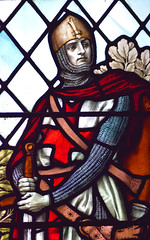 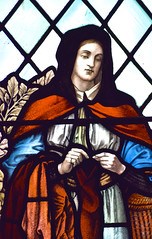 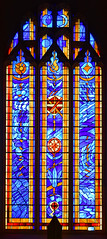 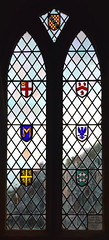 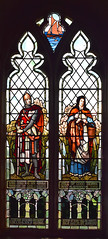
Hemsby church has two
great secrets. One of them is the beautiful little prayer
chapel in the parvise of the south porch, which you reach
by climbing the steps in the south-west corner of the
nave. It is very similar to the one at Blythburgh in
Suffolk. It is wonderful to think of this lovely space
being accessible to the people of Hemsby every day. The
other secret is immediately below it, and it is here, I
am afraid, that I must have a little moan. The vaulting
of the south porch is decorated with bosses, and the most
significant of them is a representation of the Assumption
of the Blessed Virgin. Such a boss survives elsewhere in
Norfolk only at Walpole St Peter, Wymondham and Norwich
Cathedral. The Assumption was the most popular feast of
the East Anglian medieval church. On the 15th of August,
the height of the harvest, a great celebration of
thanksgiving took place, and the Assumption was the most
popular dedication of Norfolk and Suffolk churches. But
unfortunately the porch is kept locked from both inside
and out, and although you can make out the boss through
the grill, you can't see it properly.
St Mary
was my 909th Norfolk church. Now, I only have two
medieval Norfolk churches still to visit, Fakenham and
Shingham. But there are plenty of post-Reformation
churches left to keep me busy and make that total up to a
round thousand. St Mary is not, perhaps, an important
building when compared with most of that number, and no
one could accuse Hemsby of being an attractive place, so
the welcoming interior in general, and the prayer chapel
above the porch in particular, seem all the more
important, especially as the church is open every day.
|
|
|
